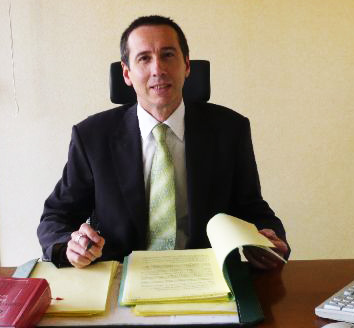Residents living near the future site of a phone mast vs. Orange Interdiction to install an Orange mobile phone antenna in a church tower.
A judge in Angers Tribunal de Grande Instance (District Court) has forbidden the Orange phone company to install mobile phone antennas in the bell tower of a church right next to a school. This judgement is a first in France, since sentence has been passed before the event.
The judge explained that his decision was based specifically on the precautionary principle.
On the initiative of a residents' action group and the parents of pupils at the school, half the 400 inhabitants in Notre Dame d'Allençon, near Angers, who organised the petition against the installation of an Orange mobile phone base - French Republic The District Court of Angers : "JUDGEMENT"
- Notre Dame d'Allençon Residents' Action Group vs.
the Mobile Telephone Company Orange SA.sta in the bell tower of their church.
Within 50 metres of it there is a nursery school and a primary school, a fact that Françoise Aubin, the protest organiser, pointed out to Orange in no uncertain terms: "It will be right on top of the nursery school and the primary school, so we want it somewhere else!"

Faced with the decision by the Town Council to grant permission for the installation, the protest group realised that they had to act, and then took the initiative by bringing a petition against Orange before the District Court in Angers.
Their defence was undertaken by Maître Denis Seguin, a lawyer who specialises in environmental law, who in his summing up emphasised the precautionary principle:
"At Notre-Dame-d'Allençon, the children would be exposed against their will."
In his plea the lawyer listed the most common pathologies caused by exposure to artificial hyperfrequency microwave radiation.
In the name of the group Maître Seguin even proposed to Orange an alternative site:
"We made a proposition, but it would mean putting up a pylon, and the cost is not the same as in the bell tower."
Through their lawyer Maître Christian Sourau, from the bar of Val d'Oise, the response from Orange was not long in coming: "The bell tower exactly meets the requirements for completing the link-up of the network. Orange respects the regulations and the recommendations from the authorities."
As for the health hazards from artificial microwave radiation, he added: "All the effects cited are not scientifically proven. The experts have not found any health hazard. At Notre Dame d'Allençon the exposure to microwave emissions will be 50 times less than the statutory limit. The beams will not be directed at the school."
On Thursday 5 March 2009, after a month of deliberation, the judgement given by the Angers Court forbids Orange to install the relay antenna in the tower.

The Court (photo) explains its decision by pointing out that the site of the school is less than 100 metres from the church, and is therefore very likely to be subjected to the radiation from the antenna.
As a result the judgement stipulates that the school should be classed as a 'sensitive' building and therefore merits the specific application of article 110 of the environment code detailing the precautionary principle.
The decision is based also on a statement in the report of Prof. Denis Zmirou, the former Scientific Director of AFSSE (Health and Safety Authority):
"There is a health risk for people living nearby."
The judge also cites the statement that: "It is preferable to reduce to a minimum the exposure level of potentially vulnerable people such as children and certain people who are sick."
In consequence, "In the light of uncertainties over the guarantees offered for the protection of a sensitive building such as the municipal school ... the precautionary principle compels us to forbid the realisation of the plans to install relay antennas in the bell tower of the church of Notre-Dame d'Allençon".
The terms of the judgement sentence the phone operator Orange to pay the sum of 2500€ to the petitioners as well as costs.
In addition to being forbidden to install the antennas, Orange is also subject to a penalty of 5000€ "per observed offence per day if they carry out the prohibited works."
______________________________________
After the publication of the report 2001, Prof. Zmirou resigned from AFSSE in 2005 with the following comment:
"We are paying today and our children will pay tomorrow the price of our blindness." (Le Monde, 09/06/2005)

The Secretary of State Nathalie Kosciusko-Morizet, who did not want the phone mast problem to come before the courts, is now in danger of being overwhelmed by civil lawsuits already in progress.
However worse may be to follow, with cases brought before the criminal courts, something that may well be not far off.
Next-up Organisation is not surprised by this judgement, which is fully in line with the growing public awareness of the potential health damage from artificial microwave radiation.
The direct involvement of the Prime Minister in the organisation of a "citizens' forum" (round table) will not change the course of events, since in our opinion the very strict prerequisites which he has specified in his letter of instruction to the Ministers concerned shows that he does not wish to tackle the real problems.
The judgement of the Angers Court will be published.
----------------------------------------------------
Montreal Gazette
3/16/09
An oncologist from Sweden's University Hospital found that after one or more years of cellphone use, there is a 5.2-fold elevated risk of malignant brain tumour in children who begin using mobile phones before the age of 20 years; the odds for other ages was 1.4.
--------------------------------------------------
Cellphones safe for kids: Health Canada
http://www.montrealgazette.com/Health/Cellphones+safe+kids+Health+Canada/1402789/story.html
By Sarah Schmidt, Canwest News ServiceMarch 18, 2009 5:02 PM
Coral Scott, 8 years, talks on her cellphone in Montreal. Health Canada is sticking to its position that children and teenagers are not risking their health by using cellphones in the wake of new research showing they are five times more likely to suffer from a malignant brain tumour later in life if they use them.
Photograph by: Tyrel Featherstone, Montreal Gazette
OTTAWA — Health Canada is sticking to its position that children and teenagers are not risking their health by using cellphones in the wake of new research showing they are five times more likely to suffer from a malignant brain tumour later in life if they use them.
The department on Wednesday reaffirmed its position that it "currently sees no scientific reason to consider the use of cellphones as unsafe. There is no convincing evidence of increased risk of disease from exposure to radio frequency electromagnetic fields from cellphones."
Health Canada also pointed out this conclusion is similar to the positions of the World Health Organization, the International Committee on Non-Ionizing Radiation Protection and the European Union's Scientific Committee on Emerging and Newly Identified Health Risks.
Health Canada was responding to newly published findings of 15 studies from health researchers in six different countries in a special edition of a peer-reviewed academic journal. The issue is devoted to new research on the effects of electromagnetic fields (EMF) and radio frequency radiation on living cells and on the health of humans.
"Overall, the scientific evidence shows that the risk to health is significant, and that to deny it is like being in free-fall and thinking 'so far, so good'," Columbia University physiology professor Martin Blank wrote in an editorial that accompanied the report in the journal Pathophysiology.
One of the contributing authors, Swedish oncologist Dr. Lennart Hardell, has found that after one or more years of cellphone use, there is a 5.2-fold elevated risk of malignant brain tumours in children who begin using mobile phones before the age of 20 years, whereas for all ages the odds ratio was 1.4.
On Wednesday, Blank expressed disappointment over Health Canada's position.
"Health Canada may find temporary cover in relying on the various agencies listed, but faceless authorities, who may or may not be involved in EMF research, are no substitute for the data published by the reputable scientists themselves in peer-reviewed journals. Health Canada must realize that its obligation to protect the health of its citizens requires that they alert them to the implications of the scientific findings, so that they may take precautionary measures on their own."
Cindy Sage, a co-author of one of the newly published papers on the public-health implications of wireless technologies, said Health Canada's threshold for "convincing evidence" can only mean "they require absolute proof of harm before acting. It is not in the public interest," she said.
"Scientific certainty, with all its layered requirements for causal evidence of harm, may not come for decades, and it will likely be too late for this generation of cellphone users. It took decades to establish a causal level of proof in smoking and lung cancer. Yet, had earlier precautionary warnings been issued, it could have saved tens of thousands of people from lung cancer."
© Copyright (c) Canwest News Service
---------------------------------------------
Cellphones safe for children: Agency
By Jenny Wagler, National Post
http://www.canada.com/health/Cellphones%20safe%20children%20Agency/1176420/story.html
A child uses his cellphone to take pictures. Toronto has recommended that parents limit the cellphone use of their children, but Health Canada said in response that science does not show that cellphones are unsafe.
Photograph by: AFP/Getty Images
Canada's largest city has recommended that parents limit the cellphone use of their children, but Health Canada said in response that science does not show that cellphones are unsafe.
Toronto Public Health has released a report that recommends that children cut down on their cellphone use to avoid exposure to radio frequencies, which the city says may prove to be a health risk. It recommends that children, where possible, use land lines, limit the length of cellphone calls, use headsets or hands-free options, and keep cellphones only for "essential purposes."
Ontario Premier Dalton McGuinty, responding to the city's report, agreed last week parents should limit their children's use of cellphones until more scientific research can establish if they are safe.
"I'm hardly a scientific expert on the consequences of prolonged cellphone use by children," Mr. McGuinty said. "But if I read a story, just as a dad, in the paper, I might want to speak to my kids, tell them to minimize their use, and kind of stay tuned to what the scientific community has to say on this score."
But while the Toronto agency officers and the Premier were only the latest officials to worry about the risks of cellphone use, federal public health officials in Canada and the United States have said the evidence of harm is unproven.
"Health Canada currently sees no scientific reason to consider the use of cellphones as unsafe," the organization's media officer Paul Spendlove wrote in an e-mail. "There is no convincing evidence of increased risk of disease from exposure to radio frequency electromagnetic fields from cellphones."
In the United States, the National Cancer Institute issued a lengthy fact sheet that summarizes worldwide research into cellphones and the possible link to tumours in the brain.
"Overall, research has not consistently demonstrated a link between cellular telephone use and cancer or any other adverse health effect," the institute says.
Regarding use by children specifically, the U. S. health agency said there is "no evidence that cellular telephone use poses more of a threat to children than to adults," although it does allow that children have not been the subjects of large studies and they "are likely to accumulate many years of exposure during their lives."
Loren Vanderlinden, the Toronto report's lead author, said there is hardly any research on the health impact of children's cellphone use, but that two 2007 meta-analyses of studies of adult cellphone users' health show "an association" between people who have used cellphones for 10 years or longer and both glioma and acoustic neuroma brain tumorous.
"It's an odds ratio, which shows there are higher odds for certain kinds of brain tumour," said Ms. Vanderlinden, a supervisor of environmental health assessment and policy at Toronto Public Health.
Furthermore, she said, despite the "acknowledged research gap" regarding child cellphone users' health, children would tend to be more vulnerable to brain and nervous-system cancers because their nervous systems are still developing.
But Mr. Spendlove said Health Canada has no advisories with respect to cellphone usage by school children. He said the organization identifies "concentration" as the chief personal safety issue for children using cellphones.
"For example," he said, "similar to adults not using a cellphone while driving, children should not use them while riding bicycles."
Health Canada, he said, bases its position on "the bulk of scientific evidence from animal, in vitro and epidemiological studies that have been carried out worldwide, including at our laboratory."
Marc Choma, director of communications for the Canadian Wireless Telecommunications Association, said he has "no reservations" about children using cellphones, adding that neither Health Canada nor the World Health Organization have identified any risks with cellphone use.
But the City of Toronto's report says that, while the evidence is far from conclusive, other jurisdictions are also starting to promote caution for child cellphone users.
The British Department of Health, it says, recommends that child cellphone users limit their exposure by keeping all calls short. The Belgian Federal Public Service and the Health General Directorate in France, it says, recommend that children and pregnant women limit their cellphone use and use land lines wherever possible. And the Russian Ministry of Health, it says, recommends that individuals under 18 not use cellphones at all.
"Everybody's clear on the uncertainty and the inconclusive nature of the science," Ms. Vanderlinden said, "but that it shouldn't stop precautionary policy and advice to parents on simple ways that [parents] might pay attention to their children's use of cellphones."
© Copyright (c) Canwest News Service


